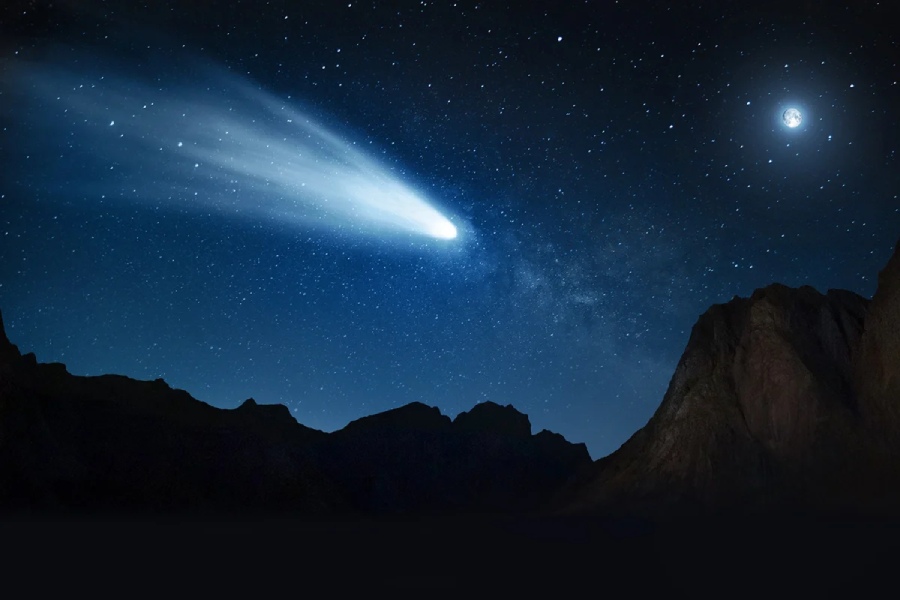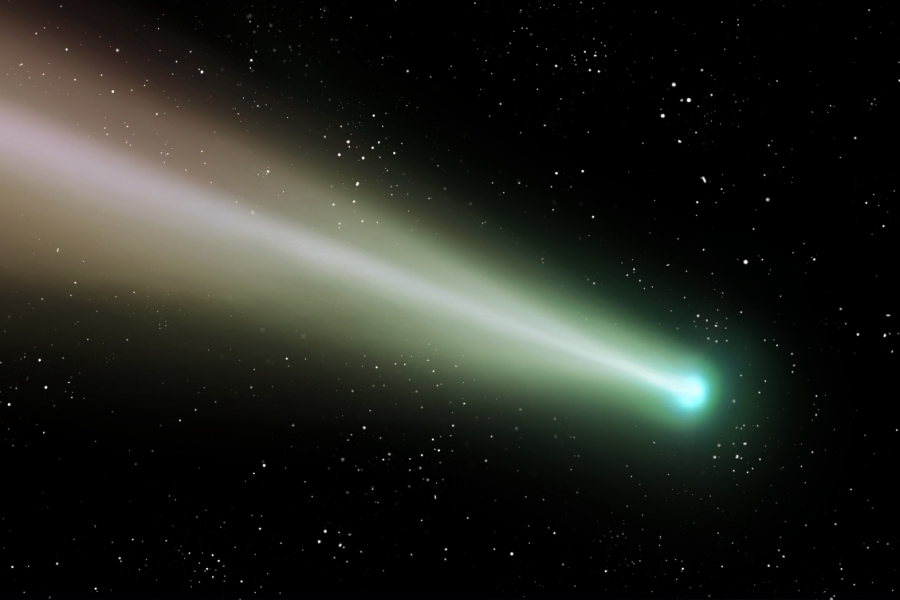On a clear night, you may have seen a comet’s tail streaking across the sky. These cosmic snowballs put on a dazzling show, but what is their mysterious origin? In this article, we’ll explore the fascinating question – where do comets come from?
Comets are icy objects that develop wide, glowing tails as they swing through the inner Solar System. But where do they exist when they are not lighting up our skies? Scientists study comets closely to piece together clues about their distant home and how they form.
Observing their structure and composition provides tantalizing hints about the birthplace of these nomadic space rocks. Join us on a journey to investigate the intriguing source of comets before they make their brilliant appearances.
Tracking the orbits of these cosmic wanderers can reveal a great deal about the far outer reaches of our solar system and beyond. Unlocking the secrets of a comet’s origins gives us perspective on the formation of our cosmic neighborhood. Where do these dazzling celestial vagabonds come from? Do comets come from the Kuiper belt? Read on to learn more.

Where Do Comets Come From?
Where do comets come from? Comets primarily come from two regions in our Solar System – the Kuiper belt and the Oort cloud. The Kuiper belt is a disk-shaped region beyond the orbit of Neptune, containing icy objects like comets.
The Oort cloud is much farther out and surrounds the solar system in a spherical shell. Comets are icy bodies that originate from these regions and occasionally get pulled into orbits that bring them closer to the Sun. This creates their characteristic tails as they heat up and release gas and dust.
Oort cloud – The origin reservoir
Introduction to the Oort Cloud
The Oort Cloud is a theoretical spherical cloud of trillions of icy objects that surrounds our solar system. It is located in the outermost regions of our solar system, extending out to around 100,000 astronomical units from the Sun.
The Oort cloud is thought to be the source region of long-period comets that enter the inner solar system. It was first theorized by Dutch astronomer Jan Oort in 1950.
The Oort cloud’s role in comet formation
Comets originating in the Oort cloud are believed to form in the region early in the Solar System’s history. Gravitational interactions with nearby stars and galactic tides gradually perturb them into long, elliptical orbits.
As an Oort cloud comet’s orbit brings it closer to the inner Solar System, it begins to exhibit cometary activity. The ices on the comet vaporize and stream out into the characteristic comet tail.
Study of Oort cloud comets gives insights into early Solar System formation. It also gives information about the gravitational effects that shaped their orbits over billions of years. Their pristine composition provides a glimpse of the original solar nebula.
Kuiper belt – Another source of comets
The Kuiper belt is a donut-shaped region beyond Neptune’s orbit. It extends from about 30 to 55 astronomical units from the Sun. The Kuiper belt contains thousands of icy bodies left over from the formation of the Solar System over four billion years ago. It was named after astronomer Gerard Kuiper.
Origin of short-period comets from the Kuiper belt
Comets from the Kuiper belt are believed to form close to where they are found today. Interactions with nearby planets like Neptune give them elliptical orbits. As a Kuiper belt comet approaches the Sun, its ices melt and create the signature comet tail.
These are called short-period comets with orbits less than 200 years. In contrast, Oort cloud comets have much longer, eccentric orbits originating far beyond Pluto. Kuiper belt comets let us study our solar system’s outer reaches.

Formation Process of Comets
Introduction to the protosolar nebula
The protosolar nebula was a massive, dense, rotating cloud of gas and dust. It existed before and during the formation of our solar system. This occurred over 4.5 billion years ago. It consisted primarily of hydrogen and helium leftover from the Big Bang, as well as trace amounts of heavier elements.
As gravity caused the nebula to contract and spin faster, conservation of angular momentum led it to flatten into a protoplanetary disk with a bulging center that would become the proto-Sun. The disk had distinct regions based on temperature differences.
Closer to the center, near the proto-Sun, temperatures reached thousands of degrees Fahrenheit. Farther out in the disk beyond the orbits of the future planets, temperatures were just tens of degrees above absolute zero.
This allowed icy grains of water, methane, ammonia, and other volatiles to condense and solidify. The gradient of temperatures based on distance from the proto-Sun influenced the materials that could form in each zone.
Comet formation process overview
In the frigid outer Solar System, about 4-5 billion years ago, the icy grains condensed from gases and then collided at low velocities. Sticking together through electrostatic forces in a process called gravitational accretion.
Larger bodies up to several kilometers wide slowly formed through accretion, assembling the nuclei of future comets. Occasional disturbances increased the velocity of collisions, leading to the fragmentation of some bodies. The chunks would then go on to merge with other accumulating masses.
Forming comets with distinct compositions
This sticking and fragmenting allowed comets to grow enormously over millions of years. Interactions with the gravity of the giant planets, especially Jupiter, scattered many primordial bodies outwards into highly elliptical orbits forming the Oort cloud.
Comets originating closer to Jupiter and the other giant planets incorporated more carbon and silicate materials compared to those from farther out near Pluto which had more ices.
Along with the timing, we determined the mixing proportions of various chemicals in each one. This gives comets distinct compositional signatures based on their region and era of formation over four billion years ago.
What Are Comets Made Of?
Components of comets
Comets are made up of several distinct components. At the center is the nucleus, which is the solid icy core typically just a few miles across. Surrounding the nucleus is the coma or atmosphere. The coma consists of dust particles. It also contains gases that have vaporized from the heated ices on the nucleus. This happens when the comet approaches the Sun.
Beyond the coma, comets have an extensive hydrogen envelope made of neutral hydrogen gas atoms. As solar radiation pushes on the coma gases, it streams them out into long ionized tails called plasma tails.
Plasma tails can extend millions of miles and glow due to ionization. Comets also have a separate dust tail containing larger solid particles ejected from the nucleus.
Significance of each component
Each part of a comet provides unique information. The nucleus contains the most pristine material dating back to the origins of our solar system. Analyzing the composition of the vaporized ices in the coma reveals clues about a comet’s chemistry and origin.
The hydrogen envelope shows how solar wind interacts with and shapes the gases streaming from a comet. The dust tail particles can give insights into the properties of early solids from the solar nebula.
Finally, the shapes and dynamics of plasma tails demonstrate something. They show how the Sun’s activity and radiation alter cometary material. This alteration occurs as it flows away from the nucleus.
When Are Comets Visible?
Factors influencing comet visibility
The visibility of a comet depends on both its orbit and its level of activity. Comets are only visible when their orbital path brings them relatively close to the Sun and Earth. Long-period comets like Hale-Bopp may only come near the inner Solar System once in thousands of years.
While short-period comets can be observed more frequently, a comet’s visibility also depends on how actively it is outgassing. As a comet approaches the Sun, increased heating causes more subsurface ices to vaporize, making it appear brighter and more active.
Tips for observing comets
The best time to observe a comet is typically when it makes its closest approach to Earth, maximizing its apparent brightness in the sky. Choosing a dark observing site away from light pollution also improves the ability to see fainter comets. Allowing time for eyes to become dark adapted will help as well.
Using binoculars or telescopes can enhance views and allow tracking of slowly moving comets by their star field positions. Following astronomy magazines and websites to find out when bright comets will be visible is recommended, as some may be once-in-a-lifetime events.
Conclusion
After exploring the cosmic origins of comets, we now have a better sense of where do comets come from before brightening our skies. While mysteries remain about the far outer Solar System, astronomers are piecing together a clearer picture of comet formation.
We hope you now appreciate the long, looping journeys these travelers make from a cold, dark birthplace to their brilliant displays nearer the Sun. This article has illuminated an intriguing realm beyond Pluto and shown us where dazzling comets originate.
Their spectacular visits remind us of the wonders awaiting discovery on space’s farthest frontiers. As comets blaze overhead, remember the long cosmic voyage that brought them here.
